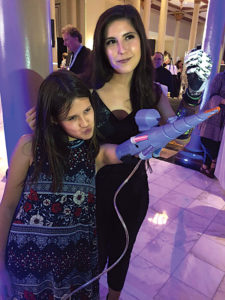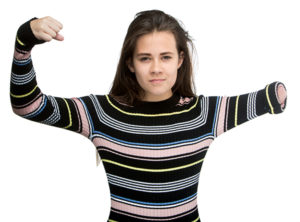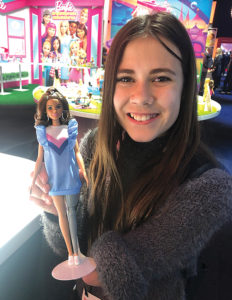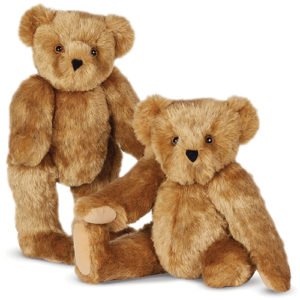By Amy Di Leo, MS
“When toy brands are including us, it helps with the whole attitude that there is nothing wrong with being different or having a disability. Without yelling it, it shows that we are here, we are okay, and we are amazing the way we are. That’s definitely something I wish existed when I was growing up!” —Angel Giuffria
ADAPTING ROLES
Angel Giuffria is on her way to becoming a household name—not just as an amputee actor but as an actor. An upper-limb amputee at birth, Giuffria is one of the first people to wear the small Steeper bebionic arm, and she sometimes goes by “bionic girl.”

When she started auditioning for roles a few years ago, she was reading for and getting roles as a bionic girl or other amputee characters. (You may have seen her in Goliath with Billy Bob Thornton on Amazon or as the cyborg archer in the API Super Bowl commercial.) Now, Giuffria is vying for mainstream roles. For her latest film role, currently in post-production, the writers adapted her character to include her limb difference.
Now that’s progress.
According to the Centers for Disease Control and Prevention, “Disability inclusion means understanding the relationship between the way people function and how they participate in society and making sure everybody has the same opportunities to participate in every aspect of life to the best of their abilities and desires.”
It’s something the limb-difference community has been working toward for decades. The process seems to have been a slow one—until now. Thanks to Giuffria and other inclusion advocates like 13-year-old Jordan Reeves, also an upper-limb amputee, the times are changing for the better.
“I was born with a left arm that stopped growing before the elbow. It happens sometimes,” says Reeves. “The story in my family is, when I arrived into the world, my dad said that I was born ‘just right.’ Meaning I am just right the way I am and also just right-handed! Get it?”
As a toddler, Reeves was already beginning to make her case for inclusion.
“It actually started when I was 4 years old,” says the Columbia, Missouri, eighth-grader. “My mom bought me an American Girl doll and a matching outfit and was saying how I looked so great matching my doll, but I knew we weren’t really matching because the doll had two hands and that bothered me.”
A 10-year-old Reeves launched a Change.org petition with her mom to encourage American Girl to include dolls with limb-difference options.
THE RIGHT MATCH
About that same time, a prosthetist from Long Island, New York, was already working with American Girl to adapt its dolls for individual children with special needs. In Erik Schaffer’s fabrication shop at A Step Ahead Prosthetics in Hicksville, New York—the same shop where his technicians create prostheses for children and adults—he began customizing American Girl dolls by creating prostheses for them. Although American Girl doesn’t offer dolls with limb difference, Schaffer says the company has been very supportive of what he is doing.
“Parents supply us with the dolls, and we do the rest,” says Schaffer. “The parents tell us about their child—type of amputation, what color the socket on the doll’s prosthesis should be, and any other pertinent information. Then we carefully cut the doll’s limb and fabricate a plug that matches the doll’s skin tone and paint it by hand. It is then inserted into the cut limb to simulate a stump. We send the dolls home to their girls with a ‘letter from the prosthetist’ detailing what a wonderful patient she was.”
Schaffer continues, “Children with limb loss and other types of difference or disability often feel excluded from the mainstream, as they aren’t always very well represented. Doing something as simple as giving a child with limb loss a doll that has a matching prosthesis can do amazing things for their self-esteem and sense of belonging.”
Schaffer adds that charging for the modifications was never even a thought because there is no way to put a price on that.
When she was 10, Reeves got one of those American Girl dolls, and it finally looked like her.
Vermont Teddy Bear jumped on board the inclusion train in 2017 with its Limb Loss & Limb Difference Bear.
“Since we design bears for everybody, why can’t we design bears for every body?” asked Cassandra Clayton, Vermont Teddy Bear product designer, as she made the pitch for the new line two years ago. “This thought, along with noticing the lack of representation in the marketplace of products that represent kids with physical differences such as limb loss/limb difference, spurred the creation.”
Clayton adds that 20 percent of the proceeds of this product go to the Amputee Coalition through its Bears That Care program because the Coalition helped guide the product with customization and provided Vermont Teddy Bear with insight into living with limb loss and limb difference.
GLITTER GIRL SHINES
As an advocate, Reeves has been seeking out and inventing new ways to make her limb difference fun. One of her ventures, Project Unicorn, brings to life her alter ego, Glitter Girl.

“I love sparkle and glitter—decorating with it and playing with it. It’s just fun—not to mention, unicorns are cool,” says Reeves. “While attending a design workshop where kids like me who have limb differences can work with designers and engineers to invent things for their different bodies, I came up with the idea of a prosthetic arm that shoots [biodegradable] glitter. I call it Project Unicorn. It’s a way for me to use my little arm in a fun and creative way.”
Reeves is currently working with a designer to create a prototype so she and other arm amputees can become an army of sparkle shooters.
“I didn’t think Project Unicorn would take off the way it did,” says Reeves. “But it did, and that confirmed that there is a big community out there of kids with disabilities and families who are looking for ways to build community and learn together.”
The invention, along with the creation of her nonprofit organization, Born Just Right (www.bornjustright.org), has given Reeves a platform to bring her quest for diversity and inclusion to the forefront. The foundation offers experiences, tips, and opportunities for children born with differences to grow up able, confident, and creative.
“It’s something that is very important to me and part of my mission in life,” Reeves says.
Reeves’ advocacy is making waves across the country—with TEDx Talks, many news articles, and interviews on national TV. In 2016, Reeves’ work got the attention of Mattel, as it was looking to expand its Barbie Fashionistas line to include dolls with disabilities. The then-tween consulted with the toy manufacturer to help designers understand why Barbie’s prosthetic leg needed to be removable for a more realistic experience.

“Barbie is such an important piece of our culture, and it was great to be able to work with the Mattel team to do it,” says Reeves about being an adviser on the new Barbie. “They really listened and wanted to get it right. That’s the kind of inclusive work that’s needed everywhere.”
The new Fashionista dolls, including a model with a wheelchair, will be available this fall.
TEACHABLE MOMENTS
While the new inclusive dolls are important for children with limb loss, they are also important for the general population.
Like Giuffria, 19-year-old Taylor Mills of Fort Wayne, Indiana, didn’t have any dolls that looked like her when she was younger. However, she’s grateful for this new generation of dolls, one of which she got for her 4-year-old sister, who was not born with limb difference.
“For me, it was more about making sure she knew that it is okay to be different, and it opened up a different playing style for her that she may not have thought about. The cool thing is that to her, the doll is no different than her other dolls, and she doesn’t treat it differently; it just happens to have a cool leg like her big sister.”
Mills adds that her sister shared the doll for show-and-tell with her preschool class and the teacher loved it and appreciated the “awesome learning experience.”
Along with the dolls, several books highlight differences, inclusion, and disability awareness, including Born Just Right, written by Reeves and her mom, Jen. Written for her peers, Reeves says the goal of the book is to help kids see their differences in a positive light.
“I hope more kids who read it will learn about disabilities and include more kids who are different in their lives,” says Reeves.
A CASE FOR REPRESENTATION
“I definitely feel we are starting to see a change in the tide,” says Giuffria. “It’s definitely starting with today’s youth, and I couldn’t be more excited about it. I’m so happy to see this younger generation moving toward embracing and celebrating their differences, because representation is the key to reducing stigma toward those with disabilities. Hopefully, this will encourage older generations to be more accepting and understanding as well.”
“Diversity and inclusion are important,” says Reeves. “We don’t all look alike, and we shouldn’t have to, so it’s time for brands to start to reflect the differences in our culture with their products so everyone feels included. It’s as simple as that.”
Here are some companies offering dolls or teddy bears with limb difference:

A Doll Like Me
www.facebook.com/nannysbabiestoodollslikeme
A Step Ahead Prosthetics
www.weareastepahead.com/community/doll-prosthetics
#ToyLikeMe
www.toylikeme.org
Vermont Teddy Bear Company.
www.vermontteddybear.com/15-limb-difference-bear
Walmart Our Generation
www.walmart.com/ip/My-Life-As-18-Poseable-Gymnast-Girl-Doll-Blonde-Hair/285027847



